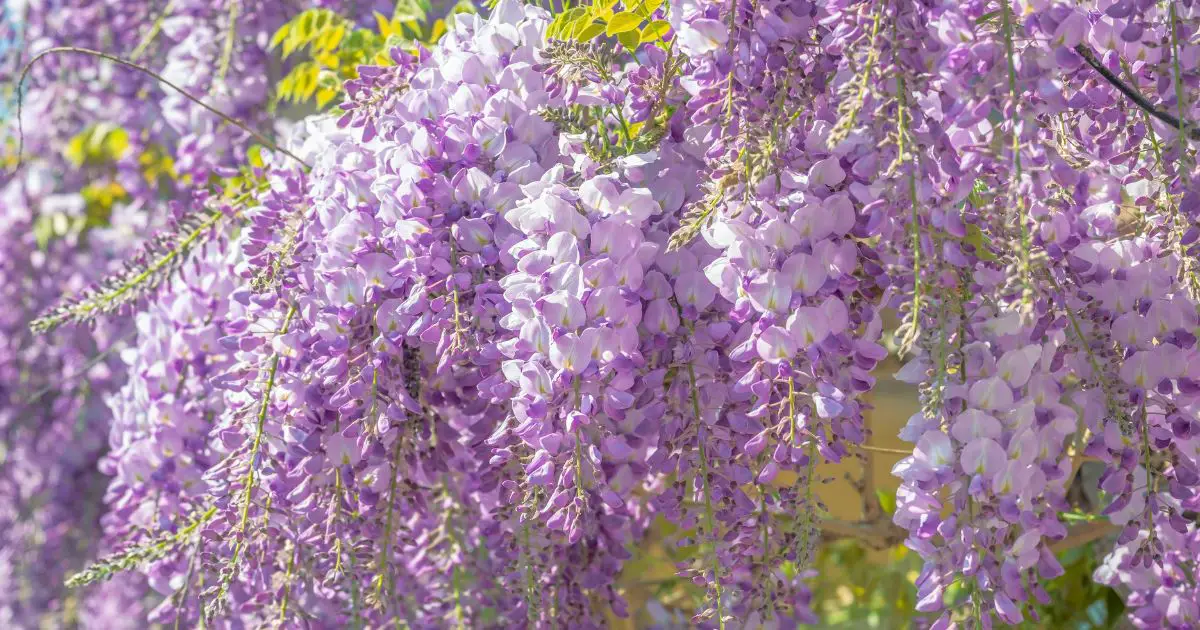Wisteria is one of the most beloved bonsai species and can be created and maintained fairly easily. Japanese wisteria is the best species for bonsai making because of its exquisite and fragrant flower clusters that bloom in a variety of colors.
Transforming Wisteria into a Bonsai
Wisteria: description
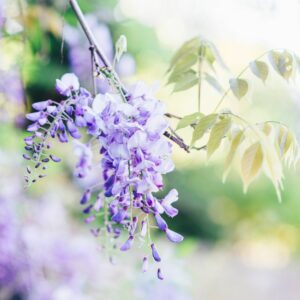
Wisteria belongs to the genus Wisteria, a group of flowering plants with woody twining vines in the bean family (Fabaceae) native to Central and East Asia and North America. They are known for their pinnately compound leaves and showy, pea-like flowers that hang in long clusters. Wisteria flowers are very fragrant and attract pollinators like bees and butterflies.
There are following 4 species in the genus Wisteria, according to the Plants of the World Online with a lot more cultivars.
- Japanese wisteria (Wisteria floribunda)
- Chinese wisteria (Wisteria sinensis)
- American Wisteria (Wisteria frutescens)
- Silky wisteria (Wisteria brachybotrys)
Among these four, Japanese wisteria and silky wisteria are native to Japan. As such, wisteria has long been celebrated in Japan for its captivating beauty. In fact, the Japanese name for wisteria, “Fuji”, is said to come from another Japanese word meaning “blown away” that depicts wisteria flowers blown by the wind.
(BTW, the Japanese word for wisteria, “Fuji”, has nothing to do with Mount Fuji, though it sounds exactly the same.)
Bonsai Potential of Wisteria
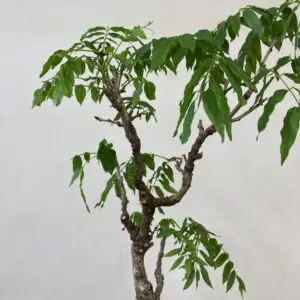
While many types of trees and shrubs can be transformed into bonsai, the process of turning a wisteria tree into a bonsai is a captivating journey and presents unique opportunities for bonsai growers. The wisteria’s blossoms are exquisite, forming abundant clusters that unfold in splendid profusion during the season of youthful greenery.
Also, wisteria exhibits rapid growth and develops a robust, mature appearance, resembling that of an aged tree. This is especially good for bonsai because it aims to create a natural landscape with trees that have an appearance of an old tree.
Moreover, due to its enduring longevity and robust reproductive capacity, wisteria holds significance as a symbol of fortune and longevity.
Is Wisteria hard to bonsai?
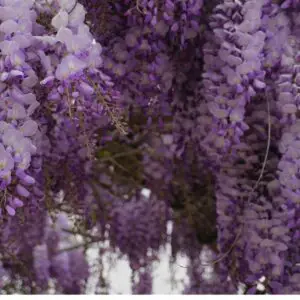
Wisteria can be made into a bonsai relatively easily as it is very sturdy and its roots grow fairly quickly to withstand root pruning. It can be propagated through grafting and air layering without difficulty.
Once made into bonsai, wisteria bonsai is not hard to maintain with regular pruning and wiring, which the tree responds very well.
One challenge for wisteria bonsai, though, is its frequent watering. Wisteria really loves water. In the summer, it can run out of water pretty fast and its roots get damaged even if you think you water it enough. This means you need to water it at least twice a day or more, especially if you live in a hot place.
Choosing the best wisteria for bonsai
Comparing Japanese, Chinese, and American Wisteria

Identifying wisteria can be challenging as there are different species and variations with similar appearances, especially for beginners.
The easiest way to identify Japanese wisteria from others is to look for its stem growth pattern; Japanese wisteria vines twine clockwise as they grow in contrast to other species like Chinese and American wisteria which twine counter-clockwise.
You can also look at the flower color, flower cluster size, flower size, and leaf size to accurately determine the specific type of wisteria.
| Japanese wisteria | Chinese wisteria | American wisteria | |
| Latin name | Wisteria floribunda | Wisteria sinensis | Wisteria frutescens |
| Native to | Japan | China | North America |
| Stem growth | Clock-wise | Counter clock-wise | Counter clock-wise |
| Leaf size | 1.5-3.0 in (4-8cm) | 2-3 in (5-7cm) | 0.8-2.5 in (2–6 cm) |
| Flower cluster size | 12-36 in (30-90cm) | 4-12 in (10-30cm) | 10–15 cm (4–6 in) |
| Flower size | 0.6-0.8 in (1.5-2.0cm) | 0.8-1.0 in (2.0-2.5cm) | 0.8 in (2 cm) |
| Flower color | Lavender, violet, lilac, pink, red, yellow, white | Lavender, violet, lilac, white | Blue, purple, white |
Japanese Wisteria (Wisteria floribunda)

Japanese wisteria
(source: 四季の山野草)
Native to
Japanese wisteria is native to Japan.
Stem growth pattern
Japanese wisteria vines twine clockwise as they grow. In fact, all the other wisteria plants, including Chinese and American wisteria, twine counterclockwise, contributing to Japanese wisteria’s unique growth habit.
Flower Characteristics
Japanese wisteria features longer and relatively smaller flower clusters. One of the famous 1200-year-old Japanese wisteria has a record of having a flower cluster of 3m.
The color of flowers is diverse, from lavender, violet, red, and pink to yellow and also white. The flowers are known for their sweet and delicate fragrance, adding sensory richness to their visual appeal.
Chinese Wisteria (Wisteria sinensis)
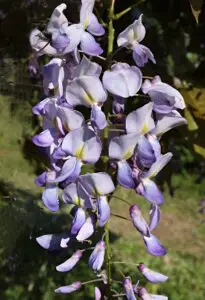
Chinese wisteria
(source: 四季の山野草)
Native to
Chinese wisteria is native to southern China.
Stem growth pattern
Chinese wisteria vines twine counterclockwise as they grow, creating a characteristic that sets them apart from Japanese wisteria.
Flower characteristics
Chinese wisteria boasts medium flower clusters in shades of lavender, violet, or white. The flowers can exhibit a moderate to strong fragrance.
American Wisteria (Wisteria frutescens)
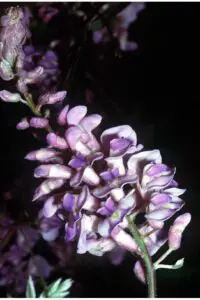
American wisteria
Native to
American wisteria is native to the South to Southeast US but is also found in Nothern states like New York.
Stem growth pattern
American wisteria vines twine counterclockwise as they grow, just like Chinese wisteria and in contrast to Japanese wisteria.
Flower characteristics
American wisteria produces shorter flower clusters. The color of flowers has less diversity compared to Japanese and Chinese wisteria; blue, purple, and white.
Characteristics of ideal wisteria bonsai

Creating a successful wisteria bonsai requires careful consideration of various characteristics that contribute to the plant’s suitability and overall aesthetic appeal. Here are some key characteristics to look for when selecting a wisteria for bonsai.
Flower Beauty
Wisteria bonsai are often appreciated for their stunning blooms. Choosing a species or variety with captivating flower clusters and colors that align with your aesthetic vision is important.
Also, different wisteria cultivars have different blooming seasons. Choosing those with different blooming season enable you to enjoy flowers from spring to early fall.
Small Leaf Size
Look for a wisteria with smaller leaves, as this is desirable for creating the illusion of a mature tree in miniature. Even within the same species and cultivar, different trees have different leaf sizes.
Interesting Bark Texture
Consider wisteria varieties with interesting and textured bark, as this adds visual interest to the bonsai.
The best wisteria for bonsai

Best wisteria species for bonsai
Selecting the right tree species is a crucial step in making wisteria bonsai, as different species possess unique growth habits, characteristics, and requirements that impact their suitability for this miniature art form.
Japanese wisteria
Among 4 species of wisteria, Japanese, Chinese and American wisteria can theoretically be made into bonsai. That said, I recommend choosing Japanese Wisteria for making a bonsai.
Japanese wisteria is well-suited for bonsai for several reasons. One of the most compelling reasons is its exquisite and fragrant flower clusters that bloom in a variety of colors, including lavender, violet, pink, and white. These flowers enhance the aesthetic beauty of your bonsai and contribute to the overall experience of growing it.
Also, Japanese wisteria has long been cultivated as bonsai species with a lot of growing experiences accumulated. This makes creating Japanese wisteria into bonsai less complicated in terms of growing and styling.
Chinese and American wisteria
Compared to Japanese wisteria, Chinese and American wisteria present certain challenges that might make them less ideal choices for bonsai.
Chinese wisteria is known for its vigorous growth and rapid thickening of vines, which can make it more challenging to maintain in a certain bonsai style. Without careful and consistent pruning, Chinese wisteria can quickly become unruly. It demands more effort to control its growth and achieve a balanced bonsai design.
American wisteria might not offer the same level of visual impact as Japanese wisteria in terms of flower colors and fragrance. While it can be suitable for certain bonsai styles, the allure of Japanese wisteria’s stunning flowers and cultural significance often make it a more attractive choice for bonsai making.
Best wisteria varieties for bonsai
Many hybrid varieties and cultivars have been developed to show specific characteristics. Look for options that align with your creative vision for your wisteria bonsai. When selecting, you should consider the following factors.
Flower characteristics

Japanese wisteria (Wisteria floribunda Macrobotrys)
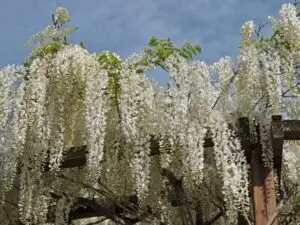
Japanese wisteria (Wisteria floribunda alba)
(Pictures from Beginners Garden)
Wisteria flowers display a range of characteristics, such as color, form, size, bloom density, cascade length, and fragrance. Choose the one that you like. One of the main reasons why you are thinking about growing wisteria bonsai, I imagine, is its beautiful flowers.
Bloom time
Different varieties bloom at different times of the year. Choose a variety with a bloom time that aligns with your preferences or you can choose several trees with different bloom times so that you can enjoy their flowers longer.
Climate
Choose a variety that thrives in your local climate conditions. While wisteria is quite sturdy as species, some varieties are more suitable for specific climates, such as warmer or cooler regions.

